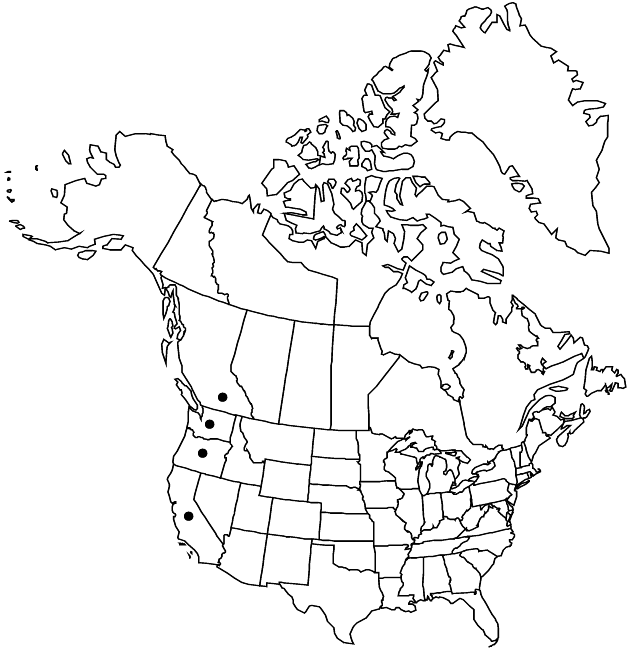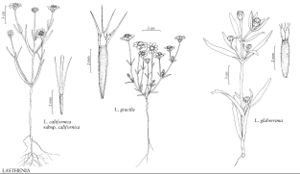Lasthenia glaberrima
in A. P. de Candolle and A. L. P. P. de Candolle, Prodr. 5: 664. 1836.
Common names: Smooth goldfields
IllustratedEndemic
Revision as of 22:53, 29 July 2020 by imported>Volume Importer
Annuals, to 35 cm. Stems erect or sprawling, branched distally, glabrous. Leaves linear, 30–100 × 2–4 (-6+) mm, (bases often connate and sheathing, apices blunt) margins entire, faces glabrous. Involucres hemispheric or campanulate, 5–7 mm. Phyllaries 5–10, ± lanceolate, hairy. Receptacles conic, papillate, glabrous. Ray-florets 6–13; (corollas pale-yellow) laminae ovate-elliptic, (0–) 0.5–2 mm. Anther appendages oblong or obovate. Cypselae grayish, somewhat flattened, ± linear, to 4 mm, hairy; pappi of 5–10 subulate to lanceolate, often fimbriate, laciniate, or aristate scales. 2n = 10.
Phenology: Flowering Mar–Jul.
Habitat: Vernal pools, wet meadows
Elevation: 0–1400 m
Distribution

B.C., Calif., Oreg., Wash.
Discussion
Selected References
None.
Lower Taxa
None.
... more about "Lasthenia glaberrima"
introrse +
connate +
herbaceous +
scarious +
absent +
hirsute +
papillate +
dilute +
continuous +
decurrent +
lobed +
winged;ribbed;winged;ribbed +
1;15 +
stigmatic +
absent +
Smooth goldfields +
zygomorphic +
pappose +
grayish +
dimorphic +
hairy +
papillate +
flattened +
0mm;4mm +
staminate +
straight +
glabrous +
distinct +
yellow +
proximal +
1;5 +
bisexual +
dispersed +
singly +
disciform +
indeterminate +
Present +
surrounding +
campanulate;hemispheric +
ovate-elliptic +
entire +
opposite +
cauline +
glabrous +
papillate +
deltate +
2-carpellate +
inferior +
attached +
anatropous +
persistent +
falling +
absent +
tough +
thick +
absent +
connate +
scarious-margined +
persistent +
connate +
herbaceous +
falling +
hairy +
unequal +
equal +
in A. P. de Candolle and A. L. P. P. de Candolle, Prodr. +
1836 +
pistillate +
absent +
fertile +
yellow +
epaleate +
glabrous +
papillate +
conic +
fibrous +
exalbuminous +
modifed +
alternate +
branched +
glabrous +
deltate +
2-branched +
papillate +
Lasthenia glaberrima +
Lasthenia sect. Lasthenia +
species +
campanulate +
equaling +
shorter +
annual +
